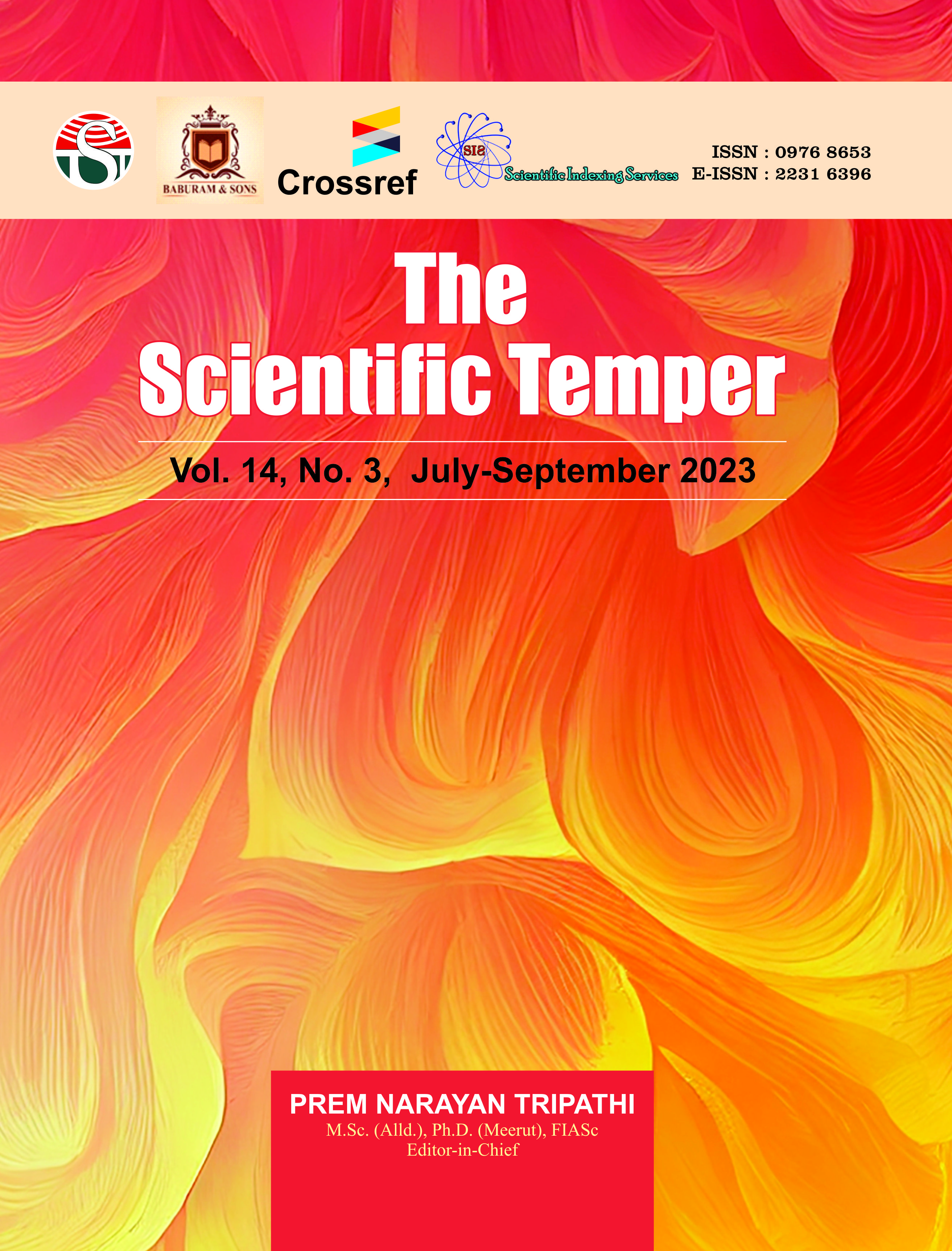Pigeonpea (Cajanus cajan L.) growth and yield with varying spacing and fertilizer
Downloads
Published
DOI:
https://doi.org/10.58414/SCIENTIFICTEMPER.2023.14.3.28Keywords:
Pigeon pea, Fertilizer, Row spacing, Yield, Fertilizer applicationDimensions Badge
Issue
Section
License
Copyright (c) 2023 The Scientific Temper

This work is licensed under a Creative Commons Attribution-NonCommercial-ShareAlike 4.0 International License.
A field experiment was conducted during kharif season of 2020 at the research farm of Amar Singh College Lakhaoti. Treatment consistedAbstract
of 3 Row spacing (30, 60 and 90 cm) and 3 levels of DAP application (control, 100 and 200 kg/ha). Results showed that treatment of
30 cm row spacing produced at par plant height compared to 60 cm row spacing. Treatment of 100 kg DAP per hectare produced
significantly plant height as compared to 200 kg DAP per hectare. The same trend was observed for a number of branches, leaves
and dry matter accumulation. Treatment of 60 cm row spacing was found to be significantly superior over 30 cm raw spacing for yield
and yield attributes treatment of 30 cm raw spacing recorded significantly higher protein content as compared to 60 cm raw spacing,
whereas treatment of 100 kg DAP per hectare was found significantly superior over control and 200 kg DAP per hectare for various
growth parameters, yield attributes and yield.
How to Cite
Downloads
Similar Articles
- S. Prabagar, Vinay K. Nassa, Senthil V. M, Shilpa Abhang, Pravin P. Adivarekar, Sridevi R, Python-based social science applications’ profiling and optimization on HPC systems using task and data parallelism , The Scientific Temper: Vol. 14 No. 03 (2023): The Scientific Temper
- B. Kalpana, P. Krishnamoorthy, S. Kanageswari, Anitha J. Albert, Machine learning approaches for predicting species interactions in dynamic ecosystems , The Scientific Temper: Vol. 15 No. 03 (2024): The Scientific Temper
- K. Mohamed Arif Khan, A.R. Mohamed Shanavas, Optimizing IoT application deployment with fog - cloud paradigm: A resource-aware approach , The Scientific Temper: Vol. 15 No. 04 (2024): The Scientific Temper
- Suresh Kumar, AGRO-WASTE MANAGEMNT BY VERMICOMPOSTING USING EISENIA FETIDA AND PERIONYX SANSIBARICUS EARTHWORMS , The Scientific Temper: Vol. 9 No. 1&2 (2018): The Scientific Temper
- Amresh Kumar Singh, Manjit Singh Chhetri, Pushyamitra Mishra, Toughness and Ductile Brittle Transition Temperature of Different Mineral Filler Reinforced TPOs Composites , The Scientific Temper: Vol. 13 No. 02 (2022): The Scientific Temper
- Basant Narain Singh, NITROGENOUS FERTILIZATION LEVELS AND ROOT MYCORRHIZAL COLONIZATION ON PLANT GROWTH AND PRODUCTIVITY IN WHEAT CROPS , The Scientific Temper: Vol. 9 No. 1&2 (2018): The Scientific Temper
- KANAKLATA ., HOST PREDILECTION STUDIES IN RANGEENI STRAIN OF LAC INSECT (KERRIA LACCA KERR) , The Scientific Temper: Vol. 10 No. 1&2 (2019): The Scientific Temper
- Sharanya Unnikrishnan, Eldhose Thomas, Arunima Dey, AI-Powered NLP in Vernacular Public Relations: Opportunities, Challenges, and Ethical Implications for India’s Multilingual Landscape , The Scientific Temper: Vol. 16 No. 10 (2025): The Scientific Temper
- Vijaylaxmi, Nirmala Koranga, Atal Bihari Bajpai, Physical Properties of Potyvirus on Chilli (Capsicum annuum) of Doon Valley in Uttarakhand , The Scientific Temper: Vol. 13 No. 02 (2022): The Scientific Temper
- Rama Shankar Dubey, M.A. Naidu, Ajay Kumar Shukla, Awadhesh Kumar Shukla, Manish Kumar, Sonia Verma, Pramod Kumar Mourya, Application of Bioactive Molecules in the Treatment and Management of Type-1 Diabetic Disease , The Scientific Temper: Vol. 13 No. 02 (2022): The Scientific Temper
<< < 1 2 3 4 5 6 7 8 9 10 > >>
You may also start an advanced similarity search for this article.



